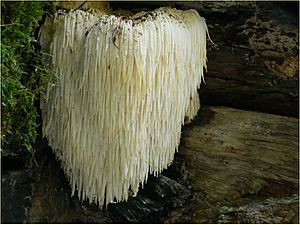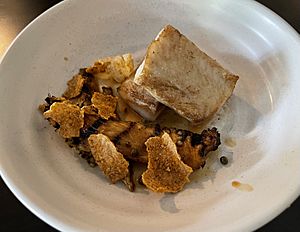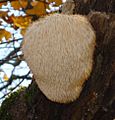Hericium erinaceus facts for kids
Quick facts for kids Hericium erinaceus |
|
|---|---|
 |
|
| Scientific classification | |
| Synonyms | |
|
| Hericium erinaceus | |
|---|---|
| Mycological characteristics | |
| teeth on hymenium | |
| no distinct cap | |
| lacks a stipe | |
| spore print is white | |
| ecology is saprotrophic | |
| edibility: choice | |
Hericium erinaceus is a special edible mushroom also known as the lion's mane mushroom, mountain-priest mushroom, or bearded tooth fungus. It belongs to a group of mushrooms called tooth funguses.
This mushroom is found in North America, Europe, and Asia. You can spot it by its long, dangling spines, which are usually longer than 1 centimeter. It often grows on hardwood trees and forms a single, large clump. People can pick its fruit bodies to use in cooking.
Hericium erinaceus can sometimes be confused with other Hericium species that grow in the same areas. In the wild, these mushrooms are common in late summer and fall. They especially like American beech and maple trees. H. erinaceus usually gets its food from dead trees, meaning it's a saprophytic organism. However, it can also grow on living trees, acting like a parasite.
Contents
- What are the Common Names for Lion's Mane?
- What Does Lion's Mane Look Like?
- How Does Lion's Mane Grow and Develop?
- Where Can You Find Lion's Mane?
- Protecting Lion's Mane Mushrooms
- Lion's Mane Strains and How Much They Grow
- How is Lion's Mane Used?
- How Does Lion's Mane Interact with Nature?
- How to Grow Lion's Mane Mushrooms
- What Other Mushrooms Look Like Lion's Mane?
- Gallery
- See also
What are the Common Names for Lion's Mane?
Both the Latin names for this mushroom, Hericium and erinaceus, mean 'hedgehog'. This is why many of its common names, like 'bearded hedgehog' and 'hedgehog mushroom', refer to a hedgehog. In German, it's called Igel-Stachelbart, which means 'hedgehog goatee'.
What Does Lion's Mane Look Like?
The fruit bodies of H. erinaceus are large and look like irregular, bumpy clumps. They can be from 5 to 40 centimeters wide. These clumps are covered with many crowded, hanging spines that produce spores. The spines are usually 1 to 5 centimeters long, or even longer.
When they are young, the fruit bodies and spines are white or cream-colored. As they get older, they can turn a yellow-brown color.
How Does Lion's Mane Grow and Develop?
The fruit bodies of H. erinaceus usually grow once a year, from August to November in Europe. It has been seen that this mushroom can grow on the same dead tree for up to 20 years. Scientists think H. erinaceus might even live for 40 years.
The mushroom produces tiny spores. The most spores are made around midday, especially when the temperature goes up and the air gets less humid. While some humidity is good for making spores, too little humidity can stop a lot of spores from being produced.
Where Can You Find Lion's Mane?
Hericium mushrooms are found all over the northern part of the world. Hericium erinaceus has been used in traditional Chinese medicine for hundreds of years. It is widely grown in Asia, often on wood logs or tree stumps.
Even though it's very popular in Asia, H. erinaceus was first described in North America. It is grown there on a smaller scale, mostly indoors. Only a few places grow it outdoors on logs. There are three Hericium species in eastern North America: H. erinaceus, H. americanum, and H. coralloides.
H. erinaceus is also native to Europe. However, it is on the IUCN Red List in 13 European countries. This means it is rare and struggling to grow and spread there. In the United Kingdom, this mushroom grows between August and December. It can keep making spores until February of the next year. It can even survive in cold and frosty weather.
Protecting Lion's Mane Mushrooms
Hericium erinaceus is rare and at risk. It is one of only four fungi in the UK that have the highest level of legal protection. This means it is against the law to pick or sell this mushroom in the UK.
Lion's Mane Strains and How Much They Grow
In mushroom farming, fungal strains are like different types of plants in crop growing. A strain comes from a single mushroom colony grown in a lab. Hericium species grow wild in North America, Europe, and Asia. Even though there's a lot of science about them, they are not often grown in large factories. Because of this, there are not many types (strains) available to buy in the USA or Europe. Not much work has been done to breed them for higher yields or other good qualities. For example, in Egypt, H. erinaceus farms reported growing about 165 grams of mushrooms from every 1 kilogram of growing material.
How is Lion's Mane Used?
Hericium erinaceus produces edible fruit bodies that are used as food and in traditional medicine. Some guides even consider it a very special mushroom to eat.
Cooking with Lion's Mane
Hericium erinaceus is popular in gourmet cooking. Young mushrooms are thought to taste the best. Along with shiitake and oyster mushrooms, H. erinaceus is a specialty mushroom. Its flavor is sometimes compared to lobster. In the USA, growing specialty mushrooms increased by about 23% between 2010 and 2018.
The fruit bodies of Hericium erinaceus contain 57% carbohydrates (8% of which is dietary fiber), 4% fat, and 22% protein.
How Does Lion's Mane Interact with Nature?
Diseases that Affect Lion's Mane
Brennandania lambi is a tiny mite that can be a pest in mushroom farms in China. This mite can grow and have babies on the H. erinaceus mushroom's mycelium (the root-like part). To stop these mites, it's important to keep the farm very clean and use heat treatments.
Competition with Other Fungi
Hericium species are good at competing with other fungi that grow on wood. They can keep their spot on dead wood, even when other fungi like Trametes versicolor and Stereum hirsutum try to take over. Hericium erinaceus has even shown to be a bit better at competing than other tooth fungi species, such as Creolophus cirrhatus and Hericium coralloides.
How to Grow Lion's Mane Mushrooms
What Does Lion's Mane Need to Grow?
Since H. erinaceus is a saprophyte that grows on dead wood, it needs the right conditions to grow. This includes good sources of carbon and nitrogen, a certain pH level, and a good balance of carbon to nitrogen.
Many different materials have been used successfully to grow this mushroom. Depending on how it's grown, the material can be solid (like an artificial log) or liquid (in a special liquid culture).
The solid material is usually a mix of sawdust from hardwood or conifer trees. This mix might also include things like wheat bran, wheat straw, soybean meal, corn meal, rice bran, and rice straw. For example, H. erinaceus can grow on beech sawdust mixed with 20% wheat bran, 25% rye grain, 7% soybean meal, 10% rapeseed meal, or 6% meat-bone flour.
An example of a liquid material for growing could be glucose for the carbon source, and soybean powder, corn powder, and wheat bran powder for the nitrogen. The best pH levels for H. erinaceus to grow well are between 5.0 and 9.0, with pH 6.0 being the very best.
What Climate Does Lion's Mane Need?
Hericium erinaceus needs a humid environment to grow, with 85 to 90% humidity in the air. The best temperature for the mushroom's mycelium (the root-like part) to grow is 25°C. The best temperature for the mushroom to grow vegetatively (to form its body) is 26°C. H. erinaceus cannot grow if the water potential is too low.
Growing Techniques for Lion's Mane
People first reported growing H. erinaceus artificially in China in 1988. It is grown using artificial logs, bottles, and special bags. However, this way of growing is not ideal for large-scale production because it doesn't produce a lot of mushrooms and takes a long time.
Another way to grow H. erinaceus is called submerged culture. In this method, the fungus grows in a liquid. This allows a lot of mycelia to be produced quickly. Special compounds from the mushroom can be taken from the fruit bodies, the mycelium grown in liquid, or the liquid itself. Growers try to make the liquid mix perfect to get a lot of H. erinaceus mycelium, along with other helpful substances. Growing in liquid is better for making mycelium and other active compounds because it creates a more even product.
Some special substances and even low-intensity red and green laser light have been shown to help mushroom spores sprout and the mycelium grow. Other types of lasers have also helped the fruit bodies grow faster.
Growing Wild Lion's Mane Strains
Wild types of Hericium species can be collected and grown. First, you gather fruit bodies from fallen trees in nature. Then, you can open the fruit bodies to get small pieces of the tissue that produces spores. This tissue is then put into petri dishes with agar (a jelly-like substance) to grow fungal colonies at 25°C. After moving the fungus to new petri dishes a few times to make sure it's pure, it can be stored at -80°C for a very long time.
What Other Mushrooms Look Like Lion's Mane?
Other mushrooms that look similar to Hericium erinaceus include Hericium americanum and Hericium coralloides.
Gallery
See also
 In Spanish: Melena de león para niños
In Spanish: Melena de león para niños






